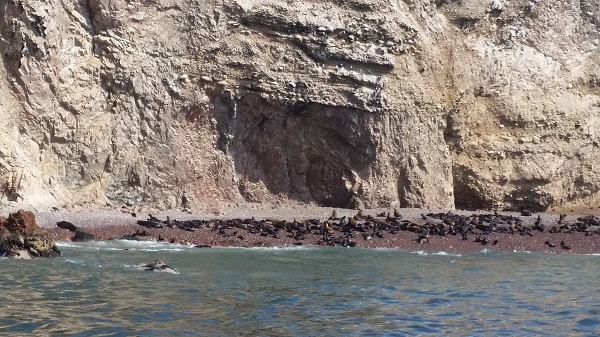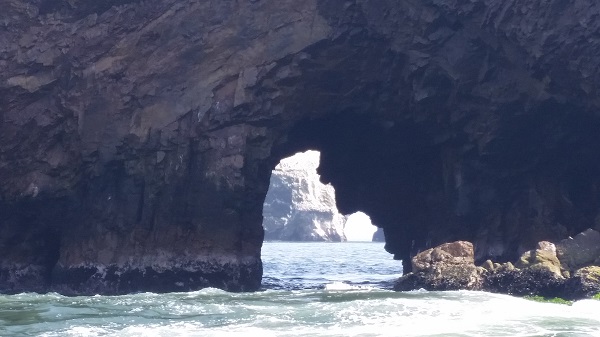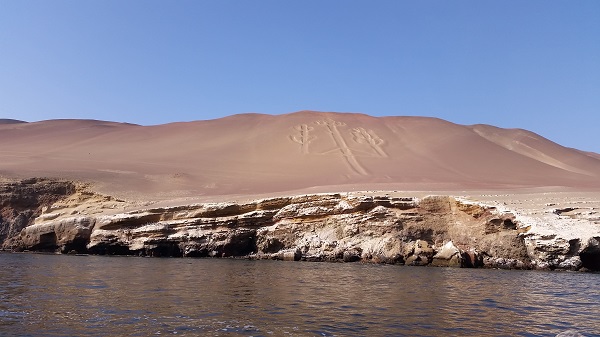 Il paesino di Paracas e' famoso per diverse ragioni: e' un bel posto di mare, offre una rispettatissima riserva naturale, ed e' stata culla della civiltà pre-incaica dei Paracas (appunto) vissuta tra il 900a.c. e il 200d.c. Inoltre per l'interessante varietà di animali che la abitano, viene chiamata 'la Galapagos dei poveri'. Noi siamo andati per tutte queste ragioni.
Appena arrivati ancora con gli zaini in spalla diretti all'ostello, abbiamo trovato l'escursione per la mattina successiva alle isole Ballestas. Non dico nemmeno quante agenzie di viaggi ed operatori c'erano in quei 500 metri di strada che abbiamo percorso dalla stazione all'ostello, tutti con gli stessi tours e con gli stessi prezzi.
Il paesino di Paracas e' famoso per diverse ragioni: e' un bel posto di mare, offre una rispettatissima riserva naturale, ed e' stata culla della civiltà pre-incaica dei Paracas (appunto) vissuta tra il 900a.c. e il 200d.c. Inoltre per l'interessante varietà di animali che la abitano, viene chiamata 'la Galapagos dei poveri'. Noi siamo andati per tutte queste ragioni.
Appena arrivati ancora con gli zaini in spalla diretti all'ostello, abbiamo trovato l'escursione per la mattina successiva alle isole Ballestas. Non dico nemmeno quante agenzie di viaggi ed operatori c'erano in quei 500 metri di strada che abbiamo percorso dalla stazione all'ostello, tutti con gli stessi tours e con gli stessi prezzi.
 Il giro che si fa e' di 1ora e mezza in barca: tutti pronti sul molo alle 8 di mattina per imbarcarsi ed andare a visitare le isole poco distanti dalla terra ferma. In poco meno di 30 minuti si raggiunge il Candelabro, un disegno a forma di candelabro o cactus che permanentemente si trova su di una collina sabbiosa. Le teorie su questo disegno sono diverse: alcuni sostengono che sia stato fatto dai Paracas in onore del cactus allucinogeno San Pedro che utilizzavano per i loro riti spirituali; altri dicono che lo abbiano fatto come riferimento di navigazione per chi era in mare; mentre un'altra teoria sostiene che il liberatore San Martin nel 1820 fece fare il candelabro come ringraziamento per la vittoria.
Non si sa, ma a distanza di molti anni si può ammirare intatto e perfetto nella sua forma e linee. Abbiamo chiesto come lo mantengono cosi ma ci hanno risposto che l'accesso all'area e' chiuso e nessuno può accedere; dicono la conservazione sia facilitata dai venti, dall'inclinazione dalla collina che lo protegge e dall'inesistente pioggia.
Non ci hanno convinto, ma del resto non si spiegano nemmeno le linee di Nazca.
La gita continua alle Isole Ballestas piene di leoni marini pigri e rumorosi, pinguini e delfini, fenicotteri rosa (cileni), uccelli di tante specie diverse come pellicani e cormorani. E' stata un'immersione nel 'magico mondo di Quark' dove abbiamo persino assistito ad un leone marino mamma insegnare al piccolo come nuotare. Meraviglioso.
Sulle isole della riserva naturale vivono per tre mesi l'anno dei ricercatori che monitorano lo stato di salute degli uccelli. Le migliaia di colonie di uccelli permettono una redditizia e prolifica produzione di guano che viene raccolto e venduto in tutto il paese.
La nostra permanenza a Paracas seppur breve e' stata molto interessante tanto che abbiamo deciso di ribattezzarla come 'sorella minore della Galapagos'.
Il giro che si fa e' di 1ora e mezza in barca: tutti pronti sul molo alle 8 di mattina per imbarcarsi ed andare a visitare le isole poco distanti dalla terra ferma. In poco meno di 30 minuti si raggiunge il Candelabro, un disegno a forma di candelabro o cactus che permanentemente si trova su di una collina sabbiosa. Le teorie su questo disegno sono diverse: alcuni sostengono che sia stato fatto dai Paracas in onore del cactus allucinogeno San Pedro che utilizzavano per i loro riti spirituali; altri dicono che lo abbiano fatto come riferimento di navigazione per chi era in mare; mentre un'altra teoria sostiene che il liberatore San Martin nel 1820 fece fare il candelabro come ringraziamento per la vittoria.
Non si sa, ma a distanza di molti anni si può ammirare intatto e perfetto nella sua forma e linee. Abbiamo chiesto come lo mantengono cosi ma ci hanno risposto che l'accesso all'area e' chiuso e nessuno può accedere; dicono la conservazione sia facilitata dai venti, dall'inclinazione dalla collina che lo protegge e dall'inesistente pioggia.
Non ci hanno convinto, ma del resto non si spiegano nemmeno le linee di Nazca.
La gita continua alle Isole Ballestas piene di leoni marini pigri e rumorosi, pinguini e delfini, fenicotteri rosa (cileni), uccelli di tante specie diverse come pellicani e cormorani. E' stata un'immersione nel 'magico mondo di Quark' dove abbiamo persino assistito ad un leone marino mamma insegnare al piccolo come nuotare. Meraviglioso.
Sulle isole della riserva naturale vivono per tre mesi l'anno dei ricercatori che monitorano lo stato di salute degli uccelli. Le migliaia di colonie di uccelli permettono una redditizia e prolifica produzione di guano che viene raccolto e venduto in tutto il paese.
La nostra permanenza a Paracas seppur breve e' stata molto interessante tanto che abbiamo deciso di ribattezzarla come 'sorella minore della Galapagos'.
Peru – Paracas After the morning in the airport in Nazca, we caught another bus to Paracas; a little trip of 4 hours to reach the natural reserve of the Ballestas Islands, on the road to Lima (the capital of Peru). Paracas
 The little village of Paracas is famous for few reasons: it is a nice beach place, it offers a well respected natural reserve, and it has been the crib of the pre-Inka civilisation of Paracas (of course!) that lived between the 900BC and 200AD. For the interesting variety of animals that lives there, it has also nicknamed 'the poor man's Galapagos'. We went for all these reasons.
When we arrived with our backpacks still on our shoulders, we found the excursion for the following morning to the Ballestas Islands. I don't need to mention how many travel agencies and tour operators there were in those 500 metres we walked to the hostel from the station, all offering the same tours and same prices.
The little village of Paracas is famous for few reasons: it is a nice beach place, it offers a well respected natural reserve, and it has been the crib of the pre-Inka civilisation of Paracas (of course!) that lived between the 900BC and 200AD. For the interesting variety of animals that lives there, it has also nicknamed 'the poor man's Galapagos'. We went for all these reasons.
When we arrived with our backpacks still on our shoulders, we found the excursion for the following morning to the Ballestas Islands. I don't need to mention how many travel agencies and tour operators there were in those 500 metres we walked to the hostel from the station, all offering the same tours and same prices.
 The tour was 1 hour and a half by boat: all ready on the pier at 8am to board and go to visit the islands, not too far from the land. In less then 30 minutes we reached the Candelabra, a drawing with the shape of a candelabra or cactus that permanently it is on a sandy hill. The theories on this drawing are many: some claim that it has been done by the Paracas in honour of the hallucinogen cactus San Pedro used during their spiritual rituals; others say that they did it as nautical reference for who was on the water; while others sustain that the liberator San Martin in 1820 requested this candelabra as thanks giving for his victory.
It is unknown, but after so many years it can be admired intact and perfect in its shape and lines.
We asked how they maintain it as it is, but they answered that the access on the area is restricted and none can access to it. They said that the conservation is facilitated by the winds, by the inclination of the hill that protects it and by the no-existent rain.
They did not convince us, also the Nazca's lines can't be explained.
The tour continued to the Ballestas Islands full of lazy and loud sea lions, penguins and dolphins, pink flamingos (from Chile), many species of birds like pelicans and cormorants. It has been a full immersion into one of 'the national geographic documentary', where we watched also a sea lion mum teaching her cub to swim. Wonderful.
On the islands of the natural reserve, there are researchers who live there for three months monitoring the heath state of the birds. The thousands of birds colonies allow a prolific and profitable production of guano, that is collected and sold in all country.
Our staying in Paracas, even if short, has been really interesting, so that we decided to rename it as 'the little sister of Galapagos Islands'.
The tour was 1 hour and a half by boat: all ready on the pier at 8am to board and go to visit the islands, not too far from the land. In less then 30 minutes we reached the Candelabra, a drawing with the shape of a candelabra or cactus that permanently it is on a sandy hill. The theories on this drawing are many: some claim that it has been done by the Paracas in honour of the hallucinogen cactus San Pedro used during their spiritual rituals; others say that they did it as nautical reference for who was on the water; while others sustain that the liberator San Martin in 1820 requested this candelabra as thanks giving for his victory.
It is unknown, but after so many years it can be admired intact and perfect in its shape and lines.
We asked how they maintain it as it is, but they answered that the access on the area is restricted and none can access to it. They said that the conservation is facilitated by the winds, by the inclination of the hill that protects it and by the no-existent rain.
They did not convince us, also the Nazca's lines can't be explained.
The tour continued to the Ballestas Islands full of lazy and loud sea lions, penguins and dolphins, pink flamingos (from Chile), many species of birds like pelicans and cormorants. It has been a full immersion into one of 'the national geographic documentary', where we watched also a sea lion mum teaching her cub to swim. Wonderful.
On the islands of the natural reserve, there are researchers who live there for three months monitoring the heath state of the birds. The thousands of birds colonies allow a prolific and profitable production of guano, that is collected and sold in all country.
Our staying in Paracas, even if short, has been really interesting, so that we decided to rename it as 'the little sister of Galapagos Islands'. 